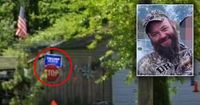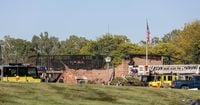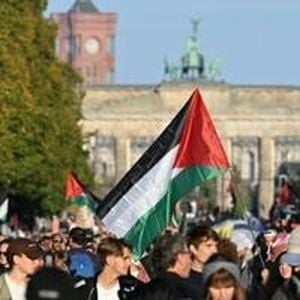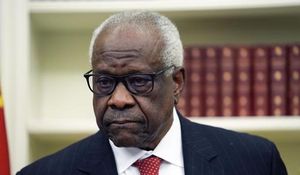On Sunday, September 28, 2025, the quiet Michigan community of Grand Blanc was shattered by a violent attack at the Church of Jesus Christ of Latter-day Saints. According to multiple news outlets including Bridge Michigan, Newsweek, and The Daily Beast, the suspect—identified by police and federal investigators as Thomas Jacob Sanford, a 40-year-old Iraq War veteran and former Marine—drove his pickup truck, emblazoned with two American flags and an Iraq War license plate, into the church during morning services. What followed was a chilling sequence of violence: Sanford began shooting inside the church, set the building on fire, and was ultimately killed in a gunfight with law enforcement officers.
The attack, which unfolded at about 10:30 a.m. as hundreds gathered for worship, left at least four people dead and eight more wounded. Authorities warned that the number of fatalities could rise, given the extent of the injuries and the chaos that erupted inside the smoke-filled sanctuary. "I know our community is hurting right now," Grand Blanc Township Police Chief William Renye told reporters late Sunday, standing alongside local law enforcement, federal agents from the Bureau of Alcohol, Tobacco, Firearms and Explosives, and U.S. Attorney Jerome Gorgon. Renye declined to answer questions and, along with other officials, did not offer a motive for Sanford’s actions.
The violence at the Grand Blanc church is part of a disturbing trend of attacks targeting religious communities across the United States. Only weeks earlier, a mass shooting at Annunciation Catholic School in Minneapolis claimed the lives of two children and injured 17 others. The Grand Blanc tragedy has reignited a national conversation around political violence, religious targeting, and the toxic polarization that seems to grip the country.
Sanford’s background is complex and, in some ways, emblematic of the broader American experience. Born and raised in Michigan, he graduated from Goodrich High School in 2003 and entered the U.S. Marine Corps, serving as a mechanic and vehicle recovery operator. According to CNN and Clarkston News, Sanford deployed to Fallujah, Iraq, following in the footsteps of his uncle, also a Marine, and a grandfather who served in the Navy during World War II. "He’s a homegrown kid who misses his family when he’s gone," his father told Clarkston News ahead of Sanford’s deployment. "Jake’s going voluntarily and plans on returning to this community when his service is over. We are very proud of him."
After returning from Iraq, Sanford settled in a brick bungalow on East Atherton Road in Burton, Michigan, about a 15-minute drive from the Grand Blanc church. Public records show he purchased the home in 2016 and registered to vote at the address in 2017. Images from Google Maps dated June 2025 show a blue Trump campaign sign hanging on his fence above a red stop sign, a detail that has fueled heated speculation about his political views. In a September 2019 Facebook post, Sanford is seen wearing a camouflage shirt emblazoned with the slogans “Re-elect Trump 2020” and “Make liberals cry again.”
Sanford’s apparent political leanings have become a focal point in the aftermath of the attack. Mark Grebner, a Michigan Democratic consultant and data expert, told Bridge Michigan that Sanford had signed two petitions in recent years: one for the Unlock Michigan campaign, which sought to repeal Democratic Governor Gretchen Whitmer’s pandemic emergency powers, and another for Right to Life Michigan, an anti-abortion initiative. However, as The Daily Beast and Newsweek point out, Michigan does not require party registration for primaries, and public records show no official party affiliation for Sanford. Social media posts from his wife, Tella Sanford, have also referenced pro-Trump hashtags, but as analysts and authorities note, the presence of campaign signs or apparel does not definitively indicate a person’s political motivations or intent.
Despite the intense scrutiny of Sanford’s political views, law enforcement officials have consistently cautioned against jumping to conclusions. Kim Vetter, spokesperson for the Michigan State Police, told reporters on Sunday night, “Any speculation about Sanford’s motives is exactly what it is—a speculation. We won’t come to those types of conclusions for some time.” The FBI, which is leading the federal investigation, echoed this sentiment, with Director Kash Patel calling the shooting and fire at the LDS church “a cowardly and criminal act.”
In the hours following the attack, President Donald Trump took to Truth Social to offer his condolences and frame the incident as part of a broader pattern. “I have been briefed on the horrendous shooting that took place at the Church of Jesus Christ of Latter-day Saints, in Grand Blanc, Michigan. The FBI was immediately on scene, and will be leading the Federal Investigation, and providing full support to State and Local Officials. The suspect is dead, but there is still a lot to learn. This appears to be yet another targeted attack on Christians in the United States of America. The Trump Administration will keep the Public posted, as we always do. In the meantime, PRAY for the victims, and their families. THIS EPIDEMIC OF VIOLENCE IN OUR COUNTRY MUST END, IMMEDIATELY!”
Other officials, including U.S. Attorney General Pam Bondi and FBI Director Kash Patel, also released statements condemning the attack and expressing sympathy for the victims and their families. “Such violence at a place of worship is heartbreaking and chilling. Please join me in praying for the victims of this terrible tragedy,” Bondi said. Patel added, “Violence in a place of worship is a cowardly and criminal act. Our prayers are with the victims and their families during this terrible tragedy.”
As investigators continue their work, the community of Grand Blanc—and the nation at large—are left to grapple with the aftermath. Sanford’s personal life, as reported by Bridge Michigan, included a 10-year-old son who was the first in the nation to receive an experimental therapy for a rare insulin disorder. In a 2016 interview, Sanford described the breakthrough as “truly a sign from heaven,” reflecting a man of faith and a devoted family member. Yet, the reasons behind his violent actions remain as elusive as ever, with police confirming that several churches closer to Sanford’s home were passed by before he targeted the Mormon congregation.
The tragedy has reignited fierce debate over the role of political rhetoric, the accessibility of firearms, and the vulnerability of religious communities. In Michigan, the memory of pandemic-era political battles and contentious debates over abortion rights loom large, with Sanford’s signature on related petitions serving as a reminder of the state’s deeply divided politics. Both sides of the political spectrum have seized on elements of the case to advance their narratives, but, as authorities warn, the full story of what drove Sanford to commit such violence is far from clear.
For now, Grand Blanc mourns its losses, and a nation watches—hoping for answers and, perhaps, a path to healing in the wake of another senseless act of violence.






